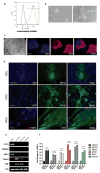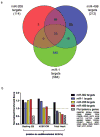Dynamic microRNA expression programs during cardiac differentiation of human embryonic stem cells: role for miR-499
- PMID: 20733065
- PMCID: PMC3057038
- DOI: 10.1161/CIRCGENETICS.109.934281
Dynamic microRNA expression programs during cardiac differentiation of human embryonic stem cells: role for miR-499
Abstract
Background: MicroRNAs (miRNAs) are a newly discovered endogenous class of small, noncoding RNAs that play important posttranscriptional regulatory roles by targeting messenger RNAs for cleavage or translational repression. Human embryonic stem cells are known to express miRNAs that are often undetectable in adult organs, and a growing body of evidence has implicated miRNAs as important arbiters of heart development and disease.
Methods and results: To better understand the transition between the human embryonic and cardiac "miRNA-omes," we report here the first miRNA profiling study of cardiomyocytes derived from human embryonic stem cells. Analyzing 711 unique miRNAs, we have identified several interesting miRNAs, including miR-1, -133, and -208, that have been previously reported to be involved in cardiac development and disease and that show surprising patterns of expression across our samples. We also identified novel miRNAs, such as miR-499, that are strongly associated with cardiac differentiation and that share many predicted targets with miR-208. Overexpression of miR-499 and -1 resulted in upregulation of important cardiac myosin heavy-chain genes in embryoid bodies; miR-499 overexpression also caused upregulation of the cardiac transcription factor MEF2C.
Conclusions: Taken together, our data give significant insight into the regulatory networks that govern human embryonic stem cell differentiation and highlight the ability of miRNAs to perturb, and even control, the genes that are involved in cardiac specification of human embryonic stem cells.
Conflict of interest statement
Figures





Comment in
-
Letter by van Mil et al regarding, "Dynamic microRNA expression programs during cardiac differentiation of human embryonic stem cells: role for miR-499".Circ Cardiovasc Genet. 2011 Feb;4(1):e3; author reply e4. doi: 10.1161/CIRCGENETICS.110.958595. Circ Cardiovasc Genet. 2011. PMID: 21325154 No abstract available.
Similar articles
-
MicroRNA-27a regulates beta cardiac myosin heavy chain gene expression by targeting thyroid hormone receptor beta1 in neonatal rat ventricular myocytes.Mol Cell Biol. 2011 Feb;31(4):744-55. doi: 10.1128/MCB.00581-10. Epub 2010 Dec 13. Mol Cell Biol. 2011. PMID: 21149577 Free PMC article.
-
MiR-199a-3p inhibition facilitates cardiomyocyte differentiation of embryonic stem cell through promotion of MEF2C.J Cell Physiol. 2019 Dec;234(12):23315-23325. doi: 10.1002/jcp.28899. Epub 2019 May 29. J Cell Physiol. 2019. PMID: 31140610
-
Target identification of microRNAs expressed highly in human embryonic stem cells.J Cell Biochem. 2009 Apr 15;106(6):1020-30. doi: 10.1002/jcb.22084. J Cell Biochem. 2009. PMID: 19229866
-
MicroRNA regulation and role in stem cell maintenance, cardiac differentiation and hypertrophy.Curr Mol Med. 2013 Jun;13(5):757-64. doi: 10.2174/1566524011313050007. Curr Mol Med. 2013. PMID: 23642057 Free PMC article. Review.
-
Embryonic stem cell microRNAs: defining factors in induced pluripotent (iPS) and cancer (CSC) stem cells?Curr Stem Cell Res Ther. 2009 Sep;4(3):168-77. doi: 10.2174/157488809789057400. Curr Stem Cell Res Ther. 2009. PMID: 19492978 Review.
Cited by
-
MicroRNA-1 enhances the angiogenic differentiation of human cardiomyocyte progenitor cells.J Mol Med (Berl). 2013 Aug;91(8):1001-12. doi: 10.1007/s00109-013-1017-1. Epub 2013 Apr 27. J Mol Med (Berl). 2013. PMID: 23625462
-
Impacts of microRNA gene polymorphisms on the susceptibility of environmental factors leading to carcinogenesis in oral cancer.PLoS One. 2012;7(6):e39777. doi: 10.1371/journal.pone.0039777. Epub 2012 Jun 28. PLoS One. 2012. PMID: 22761899 Free PMC article.
-
Let-7 family of microRNA is required for maturation and adult-like metabolism in stem cell-derived cardiomyocytes.Proc Natl Acad Sci U S A. 2015 May 26;112(21):E2785-94. doi: 10.1073/pnas.1424042112. Epub 2015 May 11. Proc Natl Acad Sci U S A. 2015. PMID: 25964336 Free PMC article.
-
Cardiovascular dysregulation of miR-17-92 causes a lethal hypertrophic cardiomyopathy and arrhythmogenesis.FASEB J. 2013 Apr;27(4):1460-7. doi: 10.1096/fj.12-221994. Epub 2012 Dec 27. FASEB J. 2013. PMID: 23271053 Free PMC article.
-
Overexpression of microRNA-1 promotes cardiomyocyte commitment from human cardiovascular progenitors via suppressing WNT and FGF signaling pathways.J Mol Cell Cardiol. 2013 Oct;63:146-54. doi: 10.1016/j.yjmcc.2013.07.019. Epub 2013 Aug 9. J Mol Cell Cardiol. 2013. PMID: 23939491 Free PMC article.
References
-
- van Laake LW, Passier R, Doevendans PA, Mummery CL. Human embryonic stem cell-derived cardiomyocytes and cardiac repair in rodents. Circulation Research. 2008;102:1008–10. - PubMed
-
- Laflamme MA, Chen KY, Naumova AV, Muskheli V, Fugate JA, Dupras SK, Reinecke H, Xu C, Hassanipour M, Police S, O’Sullivan C, Collins L, Chen Y, Minami E, Gill EA, Ueno S, Yuan C, Gold J, Murry CE. Cardiomyocytes derived from human embryonic stem cells in pro-survival factors enhance function of infarcted rat hearts. Nature Biotechnology. 2007;25:1015–24. - PubMed
-
- Bartel DP. MicroRNAs: genomics, biogenesis, mechanism, and function. Cell. 2004;116:281–97. - PubMed
Publication types
MeSH terms
Substances
Grants and funding
LinkOut - more resources
Full Text Sources
Other Literature Sources
Research Materials

